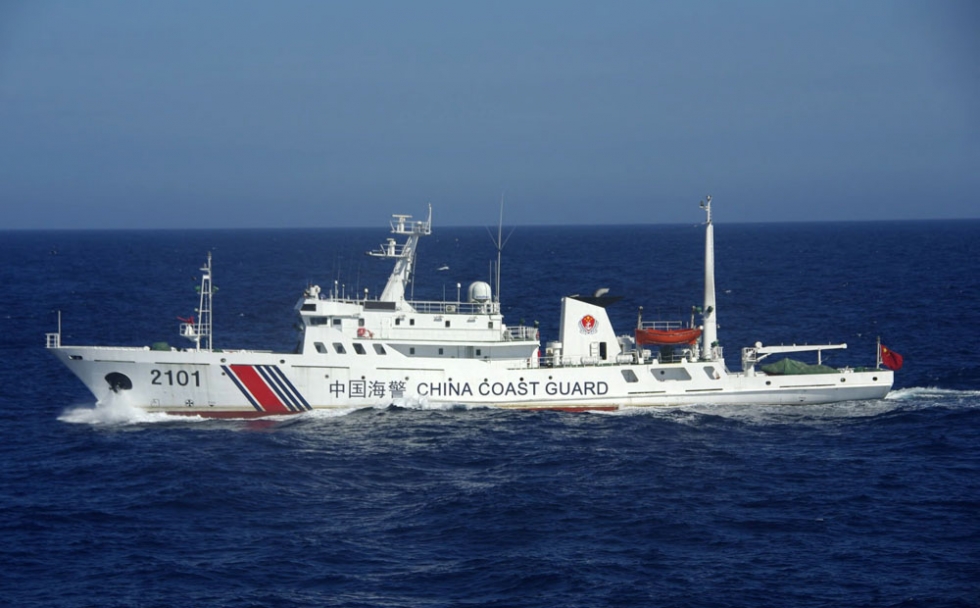
CORRECTION: Due to an editing error, this post has been updated to change the attribution of opinions in several paragraphs from RAND’s Jeffrey Hornung to CSIS’ Greg Poling.
The rapid expansion of China’s Coast Guard gives Beijing the means to shift its sea expansion aims from aspirational to operational, a panel of security experts concurred during a Monday event detailing China’s maritime ambitions.
In vast stretches of sea, an area stretching from the Senkaku Islands in the East China Sea to the Scarborough Shoals off the Phillippines in the South China Sea, China’s maritime forces are aggressively asserting claims to every landmass — natural or manmade — in this blue territory, the experts from several think tanks agreed while speaking at the Center for Strategic and International Studies.
During the past few years, China’s Coast Guard increased the number of its intrusions into the waters around the uninhabited islands dotting the East China Sea that are also claimed by Taiwan, said Masahi Murano, a fellow at the Hudson Institute. The increase, Murano added, is, “because they are rapidly building Coast Guard vessels.”
China has more than doubled the number of ships in this fleet. The People’s Liberation Army Navy controls 135 coast guard ships, translating into an increased frequency of intrusions — from three to now four times monthly — with larger, more heavily armed vessels to press China’s claims, Murano said.
Japan’s 62 coast guard vessels capable of sustained at-sea operations “are not really in position to shape Chinese actions” in the East China Sea, added Jeffrey Hornung, a political scientist at the RAND Corporation.
“Our resources are not unlimited” in finances or manpower to compete with Beijing vessel for vessel and crew for crew, Murano said. An additional limitation is Japan’s Coast Guard is a purely constabulary force.
Hornung agreed, suggesting Japan should focus investments in intelligence, surveillance and reconnaissance assets to deter and counter Chinese ambitions. Questioning Tokyo’s decision to re-purpose two destroyers partially in answer to China’s announced goal of having six aircraft carriers by 2030, Murano said, “Carriers are not the wave of the future,”
Murano said Beijing’s objective with such gray zone challenges as sending vessels to intrude into the area sending land-based aircraft on flyover missions, is to cause regional competitors to spend heavily on their defenses. Eventually, China aims to present Japan with a “fait accompli” in enforcing China’s claims to the islands, Murano said.
Further south, in the South China Sea, Beijing’s maritime ambitions are similarly presenting grey zone challenges to an American treaty ally — the Philippines. The country’s leadership “doesn’t know if it can rely on the United States” in its dispute with China over Scarborough Shoals, said Greg Poling, director of CSIS’ Asia Maritime Transparency Initiative.
Philippine President Rodrigo Duterte has questioned American resolve, at a time when an international tribunal determined in 2016 that the shoals, about 120 miles from Subic Bay, were Philippine territory, Poling said.
However, since the ruling, Poling said the dynamics in the South China Sea have changed dramatically. The Chinese have transitioned from turning coral reefs into islands to having them become effectively homeports for Chinese Coast Guard vessels and forward landing bases for maritime patrol aircraft. They have also installed sophisticated mobile air and maritime defense systems as well as jamming equipment on them.
In addition to a permanent coast guard and air presence, “300 naval militia vessels are operating every day” in the South China Sea, Poling said. They use manmade islands as home ports to send ships out to contest Vietnam’s claims to seabeds holding energy resources and minerals and contest Phillippine fishing rights to work waters in its economic zone.
The objective in all this activity is “to make it politically risky” for “civilians to operate in their own EZ’s,” he added.
“Beijing wants to shape our behavior,” Collin Koh Swee Lean, a research fellow at Nanyang Technological University in Singapore, said. “What we are seeing up is the beefing up of these outposts and [their long-term] maintenance.” He added that attention to long-term detail comes down to Chinese engineers studying the impact of the bonding or coral and concrete to ensure these bases remain in place rather than sink into the sea or have them corrode out of existence.
Long-term, China’s aims appear to involve much more than expanding maritime or territorial claims. The Chinese are pursuing “underwater observations, acoustics,” areas of importance over the next five to 10 years economically and militarily, Lean said.
Deterring China in the East China Sea needs to involve strengthening security ties between Japan, the United States and other regional powers such as Australia and India, Murano and Hornung said.
In the case of reassuring the Philippines of America’s continued commitment to its defense, Hornung said recent exercises between the two nations was a positive step. Still, they need to be expanded and made regular.
Better yet and within the already-signed treaty, terms would be to have “necessary forces rotating through” the island nation but with permanent installations as a demonstrated show of commitment to deterrence. Poling added these installations would be turned over to the Philippines when the treaty expires in 15 years.
At the same time, the United States needs to consider sanctioning Chinese officials and “shaming and naming them” for these aggressive moves across the Indo-Pacific.
The idea “is impose just enough costs” for their assertions of sovereignty over territory, waters, fisheries, minerals and energy deposits that China backs off, Poling said.





